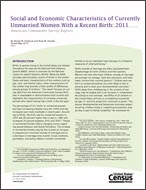Social and Economic Characteristics of Currently Unmarried Women With a Recent Birth: 2011
Social and Economic Characteristics of Currently Unmarried Women With a Recent Birth: 2011
Introduction
Births to women living in the United States are tracked throughout the year by the National Vital Statistics System (NVSS), which is overseen by the National Center for Health Statistics (NCHS). While the NVSS provides administrative counts of births in the United States and basic characteristics of the mothers such as age, race, and marital status, other characteristics of the mother may provide a fuller profile of differences among groups of mothers.1 This report focuses on survey data from the American Community Survey (ACS) that is unavailable in administrative birth records and highlights the characteristics of currently unmarried women who report having had a birth in the last year.2
The percentage of U.S. births to unmarried women has been increasing steadily since the 1940s and has increased even more markedly in recent years. According to NCHS, the birth rate for unmarried women in 2007 was 80 percent higher than it was in 1980 and increased 20 percent between 2002 and 2007.3 Trends in nonmarital fertility reflect changing norms regarding sexual behavior and family formation. The increase in nonmarital fertility may be due to both an increase in pregnancies conceived outside of marriage and to a decrease in marriage rates overall. Social scientists, journalists, and policy makers consider nonmarital fertility to be an important topic because it is linked to measures of child well-being.4
Births outside of marriage are often associated with disadvantage for both children and their parents. Women and men who have children outside of marriage are younger on average, have less education, and have lower income than married parents.5 Children who are born to unmarried parents are more likely to live in poverty and to have poor developmental outcomes.6 Shifts away from childbearing in the context of marriage may be largely due to an increase in cohabitation. According to one estimate, two-fifths of all children in the United States will live in a cohabiting household by age 12, and this proportion continues to grow.7 The poorer developmental and behavioral outcomes experienced by children living in cohabiting households may be due in part to family instability.8 An estimated 40 percent of children may see their parents break up by the time they are 15.9
The data analyzed in this report come from the 2011 ACS. This report discusses women aged 15 to 50 who gave birth in the last year and who were unmarried at the time of the survey.10 Estimates of numbers and percentages of recent births to unmarried women are presented at the national and state levels, with an additional table with metropolitan area level estimates provided on the Internet. The mothers discussed in this report include both women who do not live with the father of their child and women in cohabiting unions living in households in which the father of the child may be present.
__________
1 For a detailed comparison of NVSS data with ACS, see Appendix A on page 17 of the “Fertility of American Women: 2008” report available at <www.census.gov/library/publications/2010/demo/p20-563.html>.
2 To access administrative birth data from the NVSS, go to <www.cdc.gov/nchs/births.htm>.
3 Stephanie J. Ventura, “Changing Patterns of Nonmarital Childbearing in the United States,” NCHS Data Brief No. 18 (May 2009).
4 See Jason DeParle, “Two Classes, Divided by ‘I Do’,” New York Times, July 14, 2012 <www.nytimes.com/2012/07/15/us/two-classes-in-america-divided-by-i-do.html?pagewanted=all>.
Cynthia Osborne and Sara McLanahan, “Partnership Instability and Child Well-Being,” Journal of Marriage and Family 69.4 (November 2007).
Jane Waldfogel, Terry-Ann Craigie, and Jeanne Brooks-Gunn, “Fragile Families and Child Well-Being,” Future of Children 20.2 (Fall 2010).
5 See Sara McLanahan, “Fragile Families and the Reproduction of Poverty,” Annals of the American Academy of Political and Social Science 621 (January 2009).
6 See Rebecca M. Ryan, “Marital Birth and Early Child Outcomes: The Moderating Influence of Marriage Propensity,” Child Development 83.3 (May/June 2010).
7 Sheela Kennedy and Larry Bumpass, “Cohabitation and Children’s Living Arrangements: New Estimates from the United States,” Demographic Research 19 (September 2008).
8 R. Kelly Raley and Elizabeth Wildsmith, “Cohabitation and Children’s Family Instability,” Journal of Marriage and Family 66 (February 2004).
9 Andrew Cherlin. 2005. The Marriage Go-Round: The State of Marriage and the Family in America Today. Knopf.
10 In this report, we use the term unmarried to refer to women who were widowed, divorced, or never married at the time of the survey.
Detailed Tables
Additional File Formats
Source and Accuracy
Below is the Source and Accuracy information from the American Community Survey:
Accuracy of the Data
Others in Series
Publication
Publication
Publication









